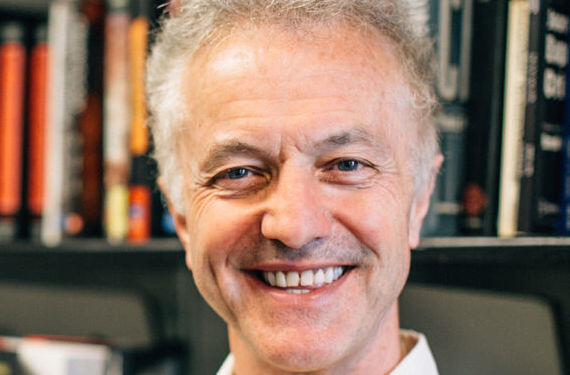Penn Professor Adrian Raine Unlocks the Criminal Mind Using Biological Keys
Barely one minute into his Penn Lightbulb Café talk on “The Anatomy of Violence,” University of Pennsylvania professor Adrian Raine pointed to a slide projected on the screen behind him that showed the cracked skull of a 19th–century railroad worker Phineas Gage, alongside a sepia-colored image of the maimed man.
In 1851, an ill-fated accident left Gage “psychopathic like,” Raine said. A metal rod had torn through the man’s brain, damaging the pre-frontal cortex. This area controls decision-making, intense emotions, impulses, insight and the ability to learn from mistakes.
It is the part of the brain that Raine calls “our guardian angel of behavior.”
“If it is asleep,” he says, “the devil can come out.”
After the accident, the railroad foreman became impulsive, lost his inhibitions, drank and gambled heavily and adopted an aimless lifestyle, losing all his friends.
In his talk, Raine covered the neuroscience of crime and its implications for societal views of moral responsibility, free will and punishment. A Penn Integrates Knowledge Professor, he is the Richard Perry University Professor of Criminology, Psychiatry and Psychology with appointments in the School of Arts & Sciences and the Perelman School of Medicine. Raine challenged the audience to ponder the ethics of punishing prisoners if the neural circuitry underlying their morality is compromised.
Next, he presented the case of Randy Kraft, who murdered 64 people in Southern California in the 1980s.
Raine pointed to a slide with a bird’s eye view of the prefrontal cortex of Kraft’s brain, which showed extensive brain activity, unlike the brain scan of a murderer that lacked such activation.
He says this showed in part how Kraft was able to escape detection for 12 years. He had good frontal cortical function, allowing him to plan and regulate his behavior.
The slide included an image of Raine’s own brain scan, which, the affable professor joked, is eerily similar to that of the multiple murderer.
The self-deprecating remark garnered a laugh from the packed house at the World Café Live located on the eastern edge of the Penn campus. The venue is home to the 10-year-old Penn Science Café series and sister lecture series, the Penn Lightbulb Café.
The din of dinner conversations quieted to a whisper as Raine addressed the moral dilemma of “helping or handcuffing” a mother who gives birth to a baby testing positive for heroin.
He appeared almost sheepish when he said to the audience, “I hope there’s no one here pregnant and taking drugs.”
He then laid out the case of Jamillah Falls, convicted in 2014 of assault and sentenced to six months in prison after her newborn tested positive for heroin and marijuana.
Another case Raine presented involved a man with a tumor growing in the prefrontal cortex. However, unlike Phineas Gage who lost his inhibitions and became a ne’er-do-well, the man known as “Michael” became a predatory pedophile.
When neurosurgeons removed the tumor, he returned to normal and reunited with his family. But six months later the tumor had grown back. His wife found child pornography on his computer and divorced him. The tumor was removed for the second time, and Michael again returned to normal, losing his “acquired pedophilia.”
Like all Penn Café lectures, Raine’s talk lasted 30 minutes and was followed by a half-hour audience question-and-answer period. Some of the questioners had read Raine’s book The Anatomy of Violence: Dissecting the Biological Roots of Crime and asked him to explain research findings reported in it. About a dozen people also waited patiently to talk to Raine following the Café.
Raine said that he was impressed by the depth and breadth of audience members’ knowledge about the lecture topic.
“I was amazed at the engagement of the people and vibrancy of the questions. It was really like a class, a really good class where students ask a lot of questions and are very open minded.”








